英语倒装句(PPT课件)
合集下载
高中英语语法 倒装句语法课件(共63张PPT)
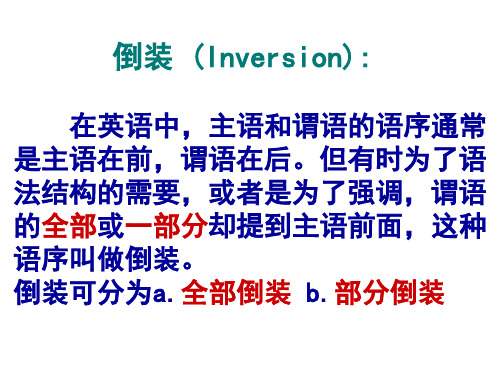
B 3. (2005江苏) ________ about wild plants that they decided to
make a trip to Madagascar for further research.
A. So curions the couple was B. So curious were the couple
open.
A. Try as she might
B. As she might try
C. She might as try
D. Might she as try
33. __D____, the boy knows a lot about computer.
A. Though is he young B. As is he young
3) 介词短语+be+主语 Among the goods are Christmas trees, flowers and toys.
6. 为了保持句子平衡或为了强调表语或状语,为 了使上下文紧密衔接。
a. inside the pyramids are the burial rooms for the s and queens.
如果后一个句子只是单纯的重复前面句子的意 思,则不倒装。
“It is hot today.” “So it is.”
“He finished it on time.” “So he did.”
当前面的句子中主语、谓语或肯否定形式不同时, 则用so it is with….,或it is the same with …句型来表 示。
A are hanging B hanged C hang D hangs
高考英语语法完全讲解——倒装结构课件(共17张PPT)

3、as和though引导的让步状语从句,采用倒装形式。 Tired as/though he was, he still went on with his work. Try as/though you might, you can’t keep the lost time. Much as/though he likes the bike, he doesn’t want to buy it.
2、whatever+n.引导让步状语从句,意为“无论什么……”, however+adj./adv.引导让步状语从句,意为“无论多么……”。
Whatever nonsense the newspapers print, some people always believe it.
However difficult the problem may be, we must work it out this evening.
形式上的倒装
形式上的倒装在语法上称为前置,特点是把强调的内容提至句首, 主谓不倒装,常见的句型主要有以下几种: 1、“the+比较级,the+比较级”意为“越……,越……”。 The more exercise you take, the healthier you are. The harder you work, the greater progress you will make.
Not until he returned did we have supper.
6、表示前面所说的情况也适合于后者时,用“so/neither/ nor+助动词/情态动词/be动词+主语”这样的倒装句式。so用于 肯定句中, neither/nor用于否定句。 He can sing English songs, and so can I. He didn't see the film, and neither did I. She likes music, and so do I. She hasn't read it, and nor have I.
《英语倒装句讲解》课件
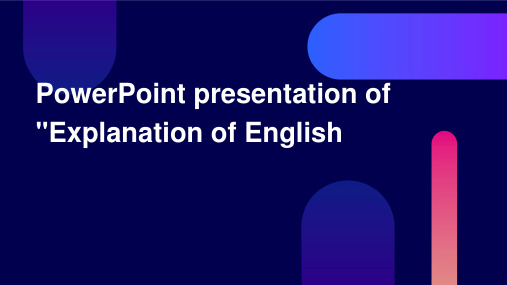
包括简单句、复合句等
。
05
Notes on Inverted English Sentences
To avoid confusion with Chinese
英语倒装句与中文表达方式存在差异, 使用倒装句可以避免与中文表达混淆。
中文中通常先说时间、地点等状语,而 英语中则将状语放在句末,使用倒装句
详细描述
英语倒装句是一种特殊的语法结构,其中句子中的词序与常规语序不同。在倒 装句中,通常将谓语动词放在主语之前,或者将修饰语放在被修饰语之前。
classification
总结词
英语倒装句的分类
详细描述
英语倒装句可以分为全倒装和部分倒装两种类型。全倒装是指整个谓语动词和主 语都颠倒位置,而部分倒装仅将助动词、情态动词或be动词放在主语之前,其他 部分保持正常顺序。
Special Inverted Sentence Structure
Special inverted sentence structures are those that deviate from the normal word order and use other grammatical structures to create emphasis or a particular effect.
These structures may include complex grammatical constructions, unusual word order, or the use of special punctuation marks.
Example: "Only after careful consideration did he make his decision."
倒装句PPT课件
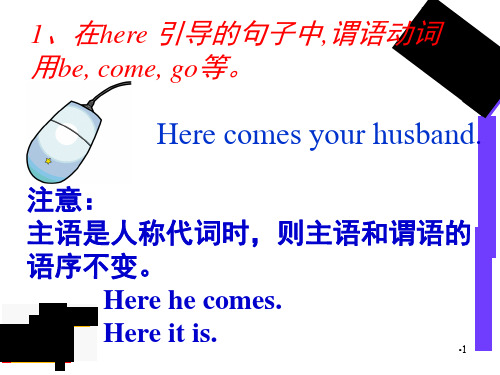
•15
6. 有些表示“感叹、祝愿”等语 气的句子,也可使用倒装结构
Eg.a. Isn‘t it cold! 天气真冷!
b. May both be happy! 祝你们两位幸福!
c. May God bless you. 愿上帝赐福于你。
d. Long live the king!
国王万岁!
•16
•9
3 、 so/such...that的so/such位于句首时 a.So loudly did the students read that people could hear them out in the street.
b.So small were the words that he could hardly see them.
______ for us.
• was the teacher ; did he care
B. was the teacher ; he cared
C. the teacher was ; did he care
D. the teacher was ; did he care
3. ___A___, he knows a lot of
C. I would believe
D. I believe
2. In __C____ and the students stood up.
A. the teacher comes
•6
• 2、为了强调only及其所修饰的
状语(通常是副词、介词短语或从 句),则将它们移到句首,句中的
主谓作部分倒装。如:
• Only then did we realize that the man was blind.
6. 有些表示“感叹、祝愿”等语 气的句子,也可使用倒装结构
Eg.a. Isn‘t it cold! 天气真冷!
b. May both be happy! 祝你们两位幸福!
c. May God bless you. 愿上帝赐福于你。
d. Long live the king!
国王万岁!
•16
•9
3 、 so/such...that的so/such位于句首时 a.So loudly did the students read that people could hear them out in the street.
b.So small were the words that he could hardly see them.
______ for us.
• was the teacher ; did he care
B. was the teacher ; he cared
C. the teacher was ; did he care
D. the teacher was ; did he care
3. ___A___, he knows a lot of
C. I would believe
D. I believe
2. In __C____ and the students stood up.
A. the teacher comes
•6
• 2、为了强调only及其所修饰的
状语(通常是副词、介词短语或从 句),则将它们移到句首,句中的
主谓作部分倒装。如:
• Only then did we realize that the man was blind.
英语语法倒装句ppt课件

Child as he is, he can tell right from wrong.
二、部分倒装
当as表示”虽然”、 “尽管”时,必须将表语,状语 (副词)或主要动词放主语前.
Though I admire his father much, I don’t like John.
Much as I admire his father, I don’t like John
在主语之前(partial inversion) 。例如:
• Only in this way can you make progress.
Practice : 句型转换 1. Look! The bus comes here. Look! ___H__er_e__c_o_m_e_s__ the bus.
二、部分倒装
4. Not until放在句首,从句不倒装,主句倒装。
They didn’t find the lost bike until last week.
Not until last week did they find the lost bike.
I didn’t realize the importance of time until I entered the university. Not until I entered the university did I realize the importance of time.
二、部分倒装
Not a word did I say to him. Never have I found him so happy. Little does he care about what I said. Seldom do I go to the cinema. Nothing did I see. Not only did he have to type out the answer, but also he has to translated it. Nowhere else in the world can there be such a beautiful place I can't swim. Neither can he.
二、部分倒装
当as表示”虽然”、 “尽管”时,必须将表语,状语 (副词)或主要动词放主语前.
Though I admire his father much, I don’t like John.
Much as I admire his father, I don’t like John
在主语之前(partial inversion) 。例如:
• Only in this way can you make progress.
Practice : 句型转换 1. Look! The bus comes here. Look! ___H__er_e__c_o_m_e_s__ the bus.
二、部分倒装
4. Not until放在句首,从句不倒装,主句倒装。
They didn’t find the lost bike until last week.
Not until last week did they find the lost bike.
I didn’t realize the importance of time until I entered the university. Not until I entered the university did I realize the importance of time.
二、部分倒装
Not a word did I say to him. Never have I found him so happy. Little does he care about what I said. Seldom do I go to the cinema. Nothing did I see. Not only did he have to type out the answer, but also he has to translated it. Nowhere else in the world can there be such a beautiful place I can't swim. Neither can he.
2024届高考英语倒装句课件(共26张PPT)

There appear some black clouds in the sky.
试卷讲评课件
4.表语置于句首时e +主语.
e.g. Happy are those who are contented.知足者常乐.
e.g. Present at the meeting were twenty teachers and thirty students.
倒装句
一、完全倒装 二、部分倒装
一、完全倒装
试卷讲评课件
整个谓语放在主语前 结构:谓语动词+主语 e.g. Away went the boy. 那个男孩走开了. 1.表示方向、时间或方位,地点的副词或介词短语,置于句首,用完全倒装. 如: here, there, now, then , up. down.in. out. away. in the room . on the wall 等。(注:主语必须是名词;若主语是代词不能倒装.)
e.g. On the table were some flowers. Then followed three days of heavy rain. Out rushed the children laughing loudly.
试卷讲评课件
2.Such置于句首时,用完全倒装。(注:such / so …that…中, such /so部 分位于句首时,句子用部分倒装.) E.g. Such are the facts: no one can deny them. 这些就是事实,没有人能否定它们. e.g. So much homework did we have to do that we had no time to have a rest.
试卷讲评课件
4.表语置于句首时e +主语.
e.g. Happy are those who are contented.知足者常乐.
e.g. Present at the meeting were twenty teachers and thirty students.
倒装句
一、完全倒装 二、部分倒装
一、完全倒装
试卷讲评课件
整个谓语放在主语前 结构:谓语动词+主语 e.g. Away went the boy. 那个男孩走开了. 1.表示方向、时间或方位,地点的副词或介词短语,置于句首,用完全倒装. 如: here, there, now, then , up. down.in. out. away. in the room . on the wall 等。(注:主语必须是名词;若主语是代词不能倒装.)
e.g. On the table were some flowers. Then followed three days of heavy rain. Out rushed the children laughing loudly.
试卷讲评课件
2.Such置于句首时,用完全倒装。(注:such / so …that…中, such /so部 分位于句首时,句子用部分倒装.) E.g. Such are the facts: no one can deny them. 这些就是事实,没有人能否定它们. e.g. So much homework did we have to do that we had no time to have a rest.
高中英语语法复习:倒装句课件(共48张PPT)
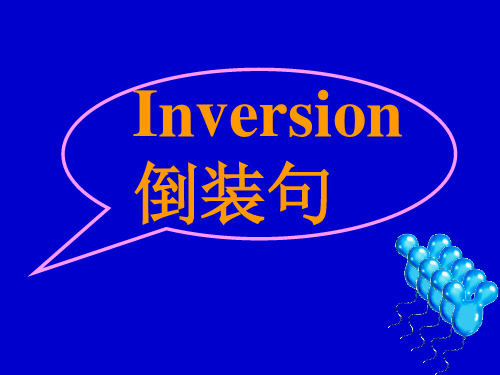
•only by wor harder can we solve the problem.
•I realized that I should have taken your advice only when I lost the game. •Only when I lost the game did I realize that I should have taken your advice.
to his wife. • Nor could his wife.
A strong negative feeling.
• 表示强调。 • 承上启下。 • 平衡结构。 • 增强句子的表现力。 • 制造悬念,渲染气氛。
基本语序
主语 + 谓语
He knew no one in Paris.
倒装语序
An old jacket hangs on the wall. Two lakes lie to the east of the city.
3. 以引导词there开头的句子,须使用倒 装结构,除 there be 外还有there live / stand
THhaorudgahshheewwoorrkkeeddh, ahredf,ahileedfa.iled.
Trhyouagshhehemmigihgth,tTtorym, Tcomuldconuoltdgneot tout goef thoeudtiofffictuhletyd.ifficulty.
Exercises: •I did not begin to do my homework until my mother came back.
Not until (my mother came back) did I begin to do my homework.
•I realized that I should have taken your advice only when I lost the game. •Only when I lost the game did I realize that I should have taken your advice.
to his wife. • Nor could his wife.
A strong negative feeling.
• 表示强调。 • 承上启下。 • 平衡结构。 • 增强句子的表现力。 • 制造悬念,渲染气氛。
基本语序
主语 + 谓语
He knew no one in Paris.
倒装语序
An old jacket hangs on the wall. Two lakes lie to the east of the city.
3. 以引导词there开头的句子,须使用倒 装结构,除 there be 外还有there live / stand
THhaorudgahshheewwoorrkkeeddh, ahredf,ahileedfa.iled.
Trhyouagshhehemmigihgth,tTtorym, Tcomuldconuoltdgneot tout goef thoeudtiofffictuhletyd.ifficulty.
Exercises: •I did not begin to do my homework until my mother came back.
Not until (my mother came back) did I begin to do my homework.
高中英语语法——倒装课件(33张ppt)

• 这个年轻科学家对他的研究如此专注以至 于每晚很迟才睡觉。(So)
• So devoted is the young scientist to his research that he goes to bed very late every night.
• 她是个热心人,乐于帮助任何有困难的人。 (Such)
• Not until their graduation from high school do a majority of students come to realize that they haven’t made the best use of time at school.
• 直到21世纪末中国运动员才开始以奥利匹 克运动会上的出色表现令世界可能不喜欢他,但必须承认他的伟大。 • Dislike him as we may, we must acknowledge his
greatness. • 尽管他想方设法,却未解决这个问题。 • Try as he might, he couldn’t solve the problem. • 钱虽然丢了,我们却得到了许多经验。 • Lose money as I did, we got a lot of experience. • 尽管落选了,但他却以其反对奴隶制的激烈演
• Only through reading widely can one master knowledge and become a talent that the society calls for.
SO
• 像他的薪水上涨一样,他对拥有一栋自己的房 子的渴望也愈加迫切。(so)
• As his salary rises, so does his desire for a house of his own.
倒装句详解ppt课件
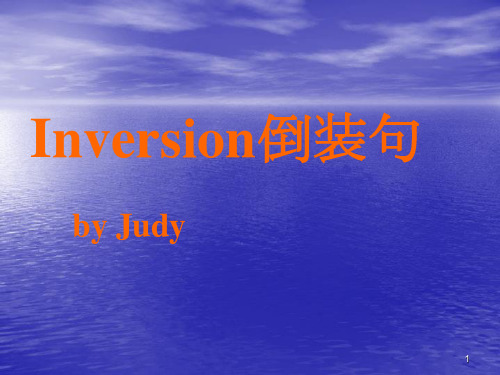
the table. (be) (2) There _l_iv_e_d__ a family of five in the village
five years ago.(live)
2、有时为了突出或强调主语,可用“表语+系动词+
主语”的完全倒装结构。
(3) ________ are the days when teachers were looked
Here you are ! Out they went.
辨 1.Here you are.
1'
别 2.There comes she.
正 误
3.In came the teacher .
4.In came he.
There ________. And here ________. 2'
A. goes the phone; she comes
__b_u__t _a_l_s_o__m__a_k_e_s__u_s__r_e_la__x_e_d_.___________________
归纳:英语的正常语序是“_主_语_ + _谓_语_”。 即主语在_前_,
谓语在_后_。 有时由于句子结构的需要或表示强调,就要采用
_倒_装_形式。将谓语动词完全移到主语之前称为_全_部_倒装;
Inversion倒装句
by Judy
1
Read, change the order and discover the rule
1' 1. Out rushed the children.T_h__e_c__h_i_ld_r_e_n__r_u_s_h__ce_od_m_op_u_let_.t_e_
3. _A_t_t_h_e_f_o_o_t_o_f_t_h_e__h_il_l _s_ta_n_d__s (坐落于山脚下)
five years ago.(live)
2、有时为了突出或强调主语,可用“表语+系动词+
主语”的完全倒装结构。
(3) ________ are the days when teachers were looked
Here you are ! Out they went.
辨 1.Here you are.
1'
别 2.There comes she.
正 误
3.In came the teacher .
4.In came he.
There ________. And here ________. 2'
A. goes the phone; she comes
__b_u__t _a_l_s_o__m__a_k_e_s__u_s__r_e_la__x_e_d_.___________________
归纳:英语的正常语序是“_主_语_ + _谓_语_”。 即主语在_前_,
谓语在_后_。 有时由于句子结构的需要或表示强调,就要采用
_倒_装_形式。将谓语动词完全移到主语之前称为_全_部_倒装;
Inversion倒装句
by Judy
1
Read, change the order and discover the rule
1' 1. Out rushed the children.T_h__e_c__h_i_ld_r_e_n__r_u_s_h__ce_od_m_op_u_let_.t_e_
3. _A_t_t_h_e_f_o_o_t_o_f_t_h_e__h_il_l _s_ta_n_d__s (坐落于山脚下)
(完整版)倒装句ppt课件

句子要用全部倒装.
全部倒装
1. Here comes the bus.
2. There goes the bell.
3. In came the teacher and the class began.
4. Out rushed the man and his son.
5. Down came the master from the upstairs.
Language Study
倒装句的定义:
英语的基本语序是:
Inversion (倒装)
“主语+谓语+…” 如果将谓语的全部或一部分放在主语之前,这种
语序叫做倒装语序。
倒装句类型:
全部倒装:谓语+主语……
1. Here comes the bus.
2. From the classroom came a strange sound.
部分倒装:助动词/情态动词+主语+谓语其它部分..
3. Do you often watch TV at night ?
4. Never shall I forget you.
全部倒装
全部倒装
1.There be/live(s)/lie(s)/stand(s)… 句型:
There are a lot of students in the classroom.
6. Away went the little boy to the school.
7. From the valley came a strange sound.
8. On the top of the mountain stood an old temple.
《倒装句完全倒装》课件

强调时间地点:在描述时间、地点的句子中,使用完全倒装的形式可以更加突出时间和地点的位置关系
完全倒装的语境适用
强调句:用于强调句子中的某个部分
疑问句:用于提出疑问,引起注意
否定句:用于表达否定,强调否定的内容
感叹句:用于表达强烈的情感,如惊讶、喜悦等
完全倒装的语用意义
强调:强调句中的某个部分,使其更加突出
强调:强调句中的某个部分,使其更加突出
平衡:使句子结构更加平衡,避免头重脚轻
平衡:使句子结构更加平衡,避免头重脚轻
05
完全倒装的辨析
完全倒装与部分倒装的区别
完全倒装:整个句子的主语和谓语完全颠倒,如"Here comes the bus."
部分倒装:只有部分句子成分颠倒,如"Only then did he realize the importance of learning English."
主语+谓语+宾语+补语:将主语和谓语位置互换,形成完全倒装句
完全倒装的常见类型
添加标题
添加标题
添加标题
添加标题
主语+谓语+宾语+补语:例如,"What a beautiful day it is!"
主语+谓语+宾语:例如,"What a beautiful day it is!"
主语+谓语+宾语+补语:例如,"What a beautiful day it is!"
完全倒装用于强调,被动语态用于表示动作的承受者
完全倒装用于祈使句,被动语态用于陈述句
06
完全倒装的练习与运用
倒装句讲解精品PPT课件全文
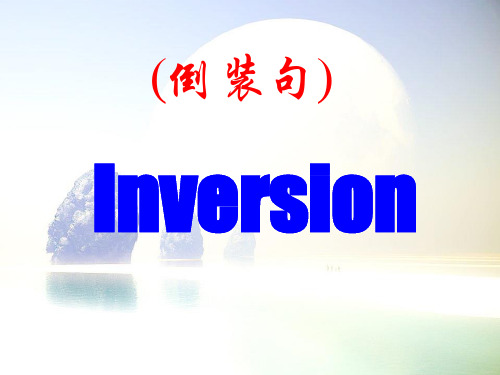
❖ 6. Especially popular were his Sunday evening dinners, usually followed by musical performances.
❖ 7. Only in recent years have women begun to catch up with men in this area.
2)当这些词作形容词修饰主语时且置句首 时,句子不倒装。 Little work was done yesterday.
5.Neither..nor连接的两个句子都要倒装; not only…but also连接的两个句子时, not only后面的句子要倒装, but also不倒装
1)Neither has he called on her, nor will he do so. 2)Not only shall we learn from books,
No sooner had they entered the house than it began to rain.
注意
1)当上述单词不提前时,则不倒装。 I seldom read newspaper before. He had hardly finished his homework when the light went out.
一、完全倒装
1. 在there, here 引导的句子中,谓语是 be, exist, live,lie 等表示状态的不及 物动词。
There is nobody in the classroom. There seems something wrong with my radio. There stands a temple on the top of the mountain.
❖ 7. Only in recent years have women begun to catch up with men in this area.
2)当这些词作形容词修饰主语时且置句首 时,句子不倒装。 Little work was done yesterday.
5.Neither..nor连接的两个句子都要倒装; not only…but also连接的两个句子时, not only后面的句子要倒装, but also不倒装
1)Neither has he called on her, nor will he do so. 2)Not only shall we learn from books,
No sooner had they entered the house than it began to rain.
注意
1)当上述单词不提前时,则不倒装。 I seldom read newspaper before. He had hardly finished his homework when the light went out.
一、完全倒装
1. 在there, here 引导的句子中,谓语是 be, exist, live,lie 等表示状态的不及 物动词。
There is nobody in the classroom. There seems something wrong with my radio. There stands a temple on the top of the mountain.
倒装句(34张PPT)初中英语专项复习课件

At the foot of the hill lies a beautiful lake. Inside the box is a cat.
介词短语 + 谓语 + 主语
注意: 主谓保持一致,(stand) Under the tree__s_t_an_d_s_ a boy. Under the tree__s_ta_n_d__ two boys.
Nowhere are we going at the weekend. •2. He did not make a single mistake.
Not a single mistake did he make. •3. We often warned them not to do so.
Often did we warn them not to do so.
•2. He had hardly fallen asleep when a knock at the door awaked her. Hardly had he fallen asleep when a knock at the door awaked her.
4.not …until…
位于句首
Exercises:
•I did not begin to do my homework until my mother came back.
Not until my mother came back did I begin to do my homework.
5) Not only…but also…连接两个句子时,部分倒装
2. _______ in the past, at the moment it is a favorite choice for
介词短语 + 谓语 + 主语
注意: 主谓保持一致,(stand) Under the tree__s_t_an_d_s_ a boy. Under the tree__s_ta_n_d__ two boys.
Nowhere are we going at the weekend. •2. He did not make a single mistake.
Not a single mistake did he make. •3. We often warned them not to do so.
Often did we warn them not to do so.
•2. He had hardly fallen asleep when a knock at the door awaked her. Hardly had he fallen asleep when a knock at the door awaked her.
4.not …until…
位于句首
Exercises:
•I did not begin to do my homework until my mother came back.
Not until my mother came back did I begin to do my homework.
5) Not only…but also…连接两个句子时,部分倒装
2. _______ in the past, at the moment it is a favorite choice for
【课件】2025届高考英语复习之部分倒装课件

My brother not only cheated me out of my money but also insulted(侮辱) my intelligence.
Not only did my brother cheat me out of my money but also insulted my intelligence.
He was such a nice guy that he received a lot of cards. Such a nice guy was he that he received a lot of cards.
二、部分倒装
部分倒装:将谓语动词的一部分(助动词/系动词/情态动词)置于 主语前 情况4:as、though引导让步状语从句时的特殊倒装 ①名词倒装(若变化前名词前面有冠词,不要冠词)(将可数名 词单数提到as前面,并删去冠词) Eg .Though his son is a child , he is able to stand on his own feet. Eg . Child though/as his son is , he is able to stand on his own feet.
Practice makes perfect !
That’s all . Thank you !
No sooner had I fallen in love than I saw that girl for the first time.
演练提升
Only after my friend came _____.
A did the computer repair
B he repaired the computer
Not only did my brother cheat me out of my money but also insulted my intelligence.
He was such a nice guy that he received a lot of cards. Such a nice guy was he that he received a lot of cards.
二、部分倒装
部分倒装:将谓语动词的一部分(助动词/系动词/情态动词)置于 主语前 情况4:as、though引导让步状语从句时的特殊倒装 ①名词倒装(若变化前名词前面有冠词,不要冠词)(将可数名 词单数提到as前面,并删去冠词) Eg .Though his son is a child , he is able to stand on his own feet. Eg . Child though/as his son is , he is able to stand on his own feet.
Practice makes perfect !
That’s all . Thank you !
No sooner had I fallen in love than I saw that girl for the first time.
演练提升
Only after my friend came _____.
A did the computer repair
B he repaired the computer
英语倒装句课件(全面详细)

1.__h_e_r_e_, _t_h_e_r_e_, _n_o_w__, _t_h_e_n等时间、地点副词置于句首
全部倒装 2.__u_p_,_d_o_w__n_,i_n_,_o_u_t_,o__ff_,a_w__a_y_等方位副词放句首 3.____介__词__短__语__________(表方位,地点)放句首
a temple stood on the mountain
There lived a little monk.
a little monk lived there
倒 装 句 inversion
Learning goals
By the end of this class, you’re expected to: 1.learn about the concept of inversion. 2.get the hang of the structure and usage of two different kinds of inversion. 3.make up the related sentences according to the clue.
A. Neither can I. B.So can I.
C. Nor do I.
D.So do I.
3. ----I often have milk and bread for breakfast. ----
______.
A. So am I. B.So have I. C. So do I. D.So did I.
全部倒装:把谓语全部提到主语之前, 即…… + 谓语 + 主语
Attention!
代词做主语时,主谓语序不变
Compare:
初高中衔接英语中的特殊句式之倒装句课件

Child though he was, he can speak five languages.
2.常考的引起部分倒装的条件:
(7) “一...就...”no sooner...than.../hardly...when...结构的倒装。
改写:As soon as she rushed out of the house, tears of regret rolled down her cheek. 她一冲出家门,悔恨的泪水就顺着脸颊滚落下来。
2.常考的引起部分倒装的条件:
(8) “也(不)是”的倒装 ”so/neither+助动词/情态动词/be动词 +主语(代词)” 正常语序: He doesn’t like eating apples. I didn’t like eating apples, either. 不喜欢吃苹果。我也不喜欢。 倒装语序:He doesn’t like eating apples. Neither do I.
No sooner had I arrived at home than the phone rang. 6.如果我有钱,我就买下它。
Had I mony, I would buy it.
改写:We can do it better only in this way.只有这样我们才能做的更好。
Only in this way can we do it better.
He admitted his mistake only after the fault was pointed out. 只有错误被指出后,他承认了自己的错误。 Only after the fault was pointed out, did he admit his mistake.
2.常考的引起部分倒装的条件:
(7) “一...就...”no sooner...than.../hardly...when...结构的倒装。
改写:As soon as she rushed out of the house, tears of regret rolled down her cheek. 她一冲出家门,悔恨的泪水就顺着脸颊滚落下来。
2.常考的引起部分倒装的条件:
(8) “也(不)是”的倒装 ”so/neither+助动词/情态动词/be动词 +主语(代词)” 正常语序: He doesn’t like eating apples. I didn’t like eating apples, either. 不喜欢吃苹果。我也不喜欢。 倒装语序:He doesn’t like eating apples. Neither do I.
No sooner had I arrived at home than the phone rang. 6.如果我有钱,我就买下它。
Had I mony, I would buy it.
改写:We can do it better only in this way.只有这样我们才能做的更好。
Only in this way can we do it better.
He admitted his mistake only after the fault was pointed out. 只有错误被指出后,他承认了自己的错误。 Only after the fault was pointed out, did he admit his mistake.
课件-部分倒装句课件ppt.ppt

Partial Inversion examples
• Seldom does he watch news on TV since he doesn’t care about what happens around the world.
• Only when the teacher is in the classroom can the students keep quiet.
篮球比赛是根据运动队在规定的比赛 时间里 得分多 少来决 定胜负 的,因 此,篮 球比赛 的计时 计分系 统是一 种得分 类型的 系统
Never will I forget the experience of learning English. Hardly had I studied in the high school when I found that English was more difficult to learn than before. Not until I failed the exam did I realize that I had to study hard and catch up with others. Try as I might , I didn’t make any progress. Later, My teacher gave me some advice: Not only should I learn English words and good sentences by heart, but also I have to know how to use them properly and correctly. Only in this way can we make great progress.
• Seldom does he watch news on TV since he doesn’t care about what happens around the world.
• Only when the teacher is in the classroom can the students keep quiet.
篮球比赛是根据运动队在规定的比赛 时间里 得分多 少来决 定胜负 的,因 此,篮 球比赛 的计时 计分系 统是一 种得分 类型的 系统
Never will I forget the experience of learning English. Hardly had I studied in the high school when I found that English was more difficult to learn than before. Not until I failed the exam did I realize that I had to study hard and catch up with others. Try as I might , I didn’t make any progress. Later, My teacher gave me some advice: Not only should I learn English words and good sentences by heart, but also I have to know how to use them properly and correctly. Only in this way can we make great progress.
- 1、下载文档前请自行甄别文档内容的完整性,平台不提供额外的编辑、内容补充、找答案等附加服务。
- 2、"仅部分预览"的文档,不可在线预览部分如存在完整性等问题,可反馈申请退款(可完整预览的文档不适用该条件!)。
- 3、如文档侵犯您的权益,请联系客服反馈,我们会尽快为您处理(人工客服工作时间:9:00-18:30)。
注意:从句的表语是名词,其名词前不加任何 冠词
6.用于So/neither (nor) + be ( have, 助动词或情 态动词) + 主语+其他的句子
表示两人的同样一个情况时,只能表示一件事,即 上、下句所使用的动词、时态要一致。否则要用so it is with…/It is the same with…
如:I have never been to Guangzhou University, neither/ nor has he.
There stood a dog before him. There exist different opinions on this question.
例题:
________ a beautiful palace ________ the foot of
the hill.
A. There stand; at
5. 为了保持句子结构平衡, 或为了强调 表语或状语,或为了使上下文结构紧凑。 They arrived at a farmhouse, in front of which sat a small boy.
强调状语
Inside the pyramids are the burial rooms for the kings and queens and long passages to these rooms.
②only修饰主语,不倒装。
3. so或so引导的短语放在句首,前半部分倒装。
I saw the film, so did she. So loudly did he speak that even people in the next room could hear him.
1) The doctor told Charlie to breathe deeply and ____. A. so did Charlie B. Charlie did so C. Charlie does so D. did Charlie so
B. There stands; under
C. Stands there; under D. There stands; at
2 ,(1).在以here、there、now、then等 副词开头的句子里。
句式:副词+vi+名词主语
“Here, There, Now, Then + come (或be,go,lie,run) + 主语" 结构。
ቤተ መጻሕፍቲ ባይዱ
3) She is not fond of cooking, ____ I.
A. so am B. nor am C. neither D. nor do
2. Only + 状语(副词/ 介词短语/ 状语从 句),位于句首 ,要部分倒装。
Only by this means is it possible to explain it. (介词短语)
He has been to Beijing. So have I. Tom can’t answer the question. Neither /Nor can I .
So +be/助动词/情态动词+主语 某人也是如此 Nor/neither +be/助动词/情态动词+主语 某人也不是如此 So +主语+be/助动词/情态动词 某人确实如此
注意:在上述句子中,如果主语为人称代词,
则主、谓不需要倒装。 In he came and back he went again.
4."分词(代词) + be + 主语"结构。
Walking at the head of the line was our teacher. Such was the story he told me.
2) —Have you ever seen anything like that
before?
—No, _____ anything like that before.
A. I never have seen B. never I have seen C.
never have I seen D. I have seen
4. "Not only + 分句,but also + 分句"句型 中的前一分句要部分倒装。
但not only...but also...连接主语时,不倒装。 如: Not only the mother but also the children are sick.
如: ___ himself wrong, but his friends were wrong.
题:________, a man of achievements, deep thoughts,
but with simple habits.
A. Einstein was such B. Such was Einstein
C. Einstein was so D. So was Einstein
He looked. He was able to look. He had looked. He looks. He can do that. He is handsome. He does those things. He hadn’t finished.
一、完全倒装
1. There be结构。另外,在此结构中可以用 来代替be动词的动词有:exist, seem, happen, appear, live, rise, stand等。
2) So loudly _____ that ____ hear her clearly. A. did she speak; could everyone B. did she speak; everyone could C. she spoke; could everyone D. she spoke; everyone could
Here comes the old lady! Then came the hour we had been looking forward to. Now comes your turn.
如果主语是人称代词,主语和谓语语序不变,不用倒装。
如:Here you are. There she comes.
3.当表示地点的介词词组(如on the wall, under the tree, in front of the house, in the middle of the room等)在句首时。
句式:介词短语+vi+主语(必须是名词)
如:At the foot of the hill lies a beautiful lake. East of the lake lie two towns. Under the tree was lying a wounded soldier.
Only then did I realize the importance of math. (副词)
Only when the war was over in 1918 was he able to get happily back to work. (从句)
注意:① 在only+状语从句+主句结构中,主句倒装, 但从句用正常语序。
I love English.
完全倒装 (full inversion) 谓语+主语
Here came the headmaster.
部分倒装 (partial inversion)
助动词/情态动词+ 主语 + 动词
Nerve will I forgive you.
1. The bell goes there. 2. The children rush out. 3. A small garden was in front of the house .
(2). 表示方向的副词out, in, up, down等 置于句首,要用全部倒装。如果主语是人称代 词,就不用倒装。如:
In came Mr. White. Up went the arrow into the air. Away went the boy.
题:There ________. And here ________. A. goes the phone; she comes B. is the phone going; is she C. does the phone go; does she come D. the phone goes; come she
A. Not was only he B. Not only he C. Not only was he D. Not only was
5、as/ though (虽然,尽管)引导的让步状语从句。
句式:名词\形容词\副词\动词\分词+as\though+主语+其他
如:
Although I am ugly, I am gentle. Ugly as I am, I am gentle. Though he is a child, he has to make a living. Child as he is, he has to make a living.
保持句子结构平衡
二、部分倒装
部分倒装是把be动词、情态动词、助动 词放到主语之前。如果句子中没有这些词, 要在主语之前加助动词do / does / did等, 而把原来的谓语动词变成原形放在主语之后。
1. 句首状语为否定词或半否定词的句子。
这类词或短语主要有never, neither, nor, little, seldom(很少,不常), rarely(很少,罕有), hardly, scarcely(几乎不,简直没有), no sooner(立即), by no means(决不) ,not only, in no way(决 不), at no time, few, not, no等,
6.用于So/neither (nor) + be ( have, 助动词或情 态动词) + 主语+其他的句子
表示两人的同样一个情况时,只能表示一件事,即 上、下句所使用的动词、时态要一致。否则要用so it is with…/It is the same with…
如:I have never been to Guangzhou University, neither/ nor has he.
There stood a dog before him. There exist different opinions on this question.
例题:
________ a beautiful palace ________ the foot of
the hill.
A. There stand; at
5. 为了保持句子结构平衡, 或为了强调 表语或状语,或为了使上下文结构紧凑。 They arrived at a farmhouse, in front of which sat a small boy.
强调状语
Inside the pyramids are the burial rooms for the kings and queens and long passages to these rooms.
②only修饰主语,不倒装。
3. so或so引导的短语放在句首,前半部分倒装。
I saw the film, so did she. So loudly did he speak that even people in the next room could hear him.
1) The doctor told Charlie to breathe deeply and ____. A. so did Charlie B. Charlie did so C. Charlie does so D. did Charlie so
B. There stands; under
C. Stands there; under D. There stands; at
2 ,(1).在以here、there、now、then等 副词开头的句子里。
句式:副词+vi+名词主语
“Here, There, Now, Then + come (或be,go,lie,run) + 主语" 结构。
ቤተ መጻሕፍቲ ባይዱ
3) She is not fond of cooking, ____ I.
A. so am B. nor am C. neither D. nor do
2. Only + 状语(副词/ 介词短语/ 状语从 句),位于句首 ,要部分倒装。
Only by this means is it possible to explain it. (介词短语)
He has been to Beijing. So have I. Tom can’t answer the question. Neither /Nor can I .
So +be/助动词/情态动词+主语 某人也是如此 Nor/neither +be/助动词/情态动词+主语 某人也不是如此 So +主语+be/助动词/情态动词 某人确实如此
注意:在上述句子中,如果主语为人称代词,
则主、谓不需要倒装。 In he came and back he went again.
4."分词(代词) + be + 主语"结构。
Walking at the head of the line was our teacher. Such was the story he told me.
2) —Have you ever seen anything like that
before?
—No, _____ anything like that before.
A. I never have seen B. never I have seen C.
never have I seen D. I have seen
4. "Not only + 分句,but also + 分句"句型 中的前一分句要部分倒装。
但not only...but also...连接主语时,不倒装。 如: Not only the mother but also the children are sick.
如: ___ himself wrong, but his friends were wrong.
题:________, a man of achievements, deep thoughts,
but with simple habits.
A. Einstein was such B. Such was Einstein
C. Einstein was so D. So was Einstein
He looked. He was able to look. He had looked. He looks. He can do that. He is handsome. He does those things. He hadn’t finished.
一、完全倒装
1. There be结构。另外,在此结构中可以用 来代替be动词的动词有:exist, seem, happen, appear, live, rise, stand等。
2) So loudly _____ that ____ hear her clearly. A. did she speak; could everyone B. did she speak; everyone could C. she spoke; could everyone D. she spoke; everyone could
Here comes the old lady! Then came the hour we had been looking forward to. Now comes your turn.
如果主语是人称代词,主语和谓语语序不变,不用倒装。
如:Here you are. There she comes.
3.当表示地点的介词词组(如on the wall, under the tree, in front of the house, in the middle of the room等)在句首时。
句式:介词短语+vi+主语(必须是名词)
如:At the foot of the hill lies a beautiful lake. East of the lake lie two towns. Under the tree was lying a wounded soldier.
Only then did I realize the importance of math. (副词)
Only when the war was over in 1918 was he able to get happily back to work. (从句)
注意:① 在only+状语从句+主句结构中,主句倒装, 但从句用正常语序。
I love English.
完全倒装 (full inversion) 谓语+主语
Here came the headmaster.
部分倒装 (partial inversion)
助动词/情态动词+ 主语 + 动词
Nerve will I forgive you.
1. The bell goes there. 2. The children rush out. 3. A small garden was in front of the house .
(2). 表示方向的副词out, in, up, down等 置于句首,要用全部倒装。如果主语是人称代 词,就不用倒装。如:
In came Mr. White. Up went the arrow into the air. Away went the boy.
题:There ________. And here ________. A. goes the phone; she comes B. is the phone going; is she C. does the phone go; does she come D. the phone goes; come she
A. Not was only he B. Not only he C. Not only was he D. Not only was
5、as/ though (虽然,尽管)引导的让步状语从句。
句式:名词\形容词\副词\动词\分词+as\though+主语+其他
如:
Although I am ugly, I am gentle. Ugly as I am, I am gentle. Though he is a child, he has to make a living. Child as he is, he has to make a living.
保持句子结构平衡
二、部分倒装
部分倒装是把be动词、情态动词、助动 词放到主语之前。如果句子中没有这些词, 要在主语之前加助动词do / does / did等, 而把原来的谓语动词变成原形放在主语之后。
1. 句首状语为否定词或半否定词的句子。
这类词或短语主要有never, neither, nor, little, seldom(很少,不常), rarely(很少,罕有), hardly, scarcely(几乎不,简直没有), no sooner(立即), by no means(决不) ,not only, in no way(决 不), at no time, few, not, no等,
